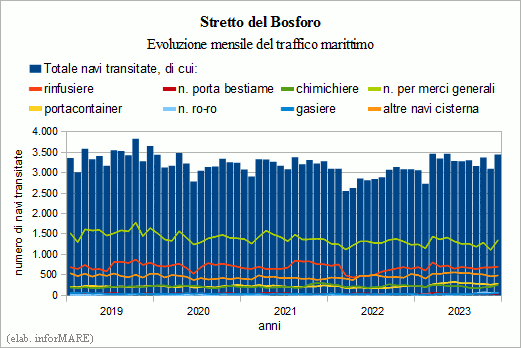
Last year, the Bosphorus Strait
a total of 39,000 ships, an increase of +11.0% on 2022,
growth that was generated by a +5.9% increase in
maritime traffic in the first quarter of 2023 over the same period
compared to the previous year, from a more substantial increase of +21.6%
in the following quarter followed by an increase of +10.8% in the
July-September last year and a progression of the
+6.4% in the last quarter of 2023 with 9,908 ships transited.
Last year, the most consistent type of vessel
transit, that of general cargo vessels, has remained
stable with 15,421 general cargoes passing through the Bosphorus
(+0,3%). The transits of the other main types of ships have
marked increases starting from bulk carriers with 8,285 ships
(+17.1%), tankers (with the exception of chemical tankers and
gas carriers) with 6,174 ships (+13.3%) and container ships with
3,376 ships (+39.2%). Chemical tankers are down with 2,671 ships
transited (-4.0%). This is followed by cattle transport ships
Vivo with 476 units (-3.1%), Ro-Ro ships with 462 units
(+68.6%), LPG/LNG vessels with 442 units (+4.2%) and
passengers with 407 units (+378.8%).
In the fourth quarter of 2023 alone, of the 9,908 ships transited
3,756 were general cargo ships (-4.6%), 2,070 bulk carriers
(+3.2%), 1,469 tankers except chemical tankers and gas carriers (+4.3%),
832 container ships (+22.9%), 668 chemical tankers (-8.9%), 213 ro-ro ships
(+147.7%) and 193 passenger ships (+865.0%).
